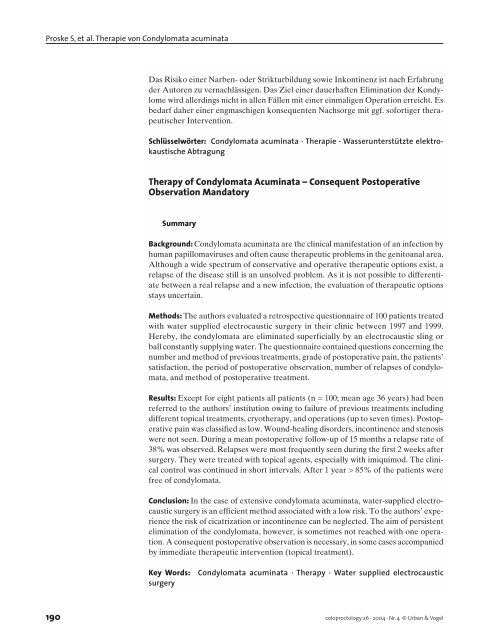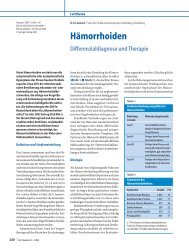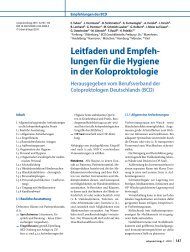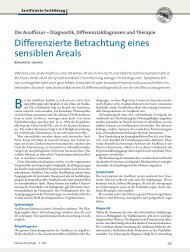Therapie von Condylomata acuminata
Therapie von Condylomata acuminata
Therapie von Condylomata acuminata
Erfolgreiche ePaper selbst erstellen
Machen Sie aus Ihren PDF Publikationen ein blätterbares Flipbook mit unserer einzigartigen Google optimierten e-Paper Software.
Proske S, et al. <strong>Therapie</strong> <strong>von</strong> <strong>Condylomata</strong> <strong>acuminata</strong><br />
Das Risiko einer Narben- oder Strikturbildung sowie Inkontinenz ist nach Erfahrung<br />
der Autoren zu vernachlässigen. Das Ziel einer dauerhaften Elimination der Kondylome<br />
wird allerdings nicht in allen Fällen mit einer einmaligen Operation erreicht. Es<br />
bedarf daher einer engmaschigen konsequenten Nachsorge mit ggf. sofortiger therapeutischer<br />
Intervention.<br />
Schlüsselwörter: <strong>Condylomata</strong> <strong>acuminata</strong> · <strong>Therapie</strong> · Wasserunterstützte elektrokaustische<br />
Abtragung<br />
Therapy of <strong>Condylomata</strong> Acuminata – Consequent Postoperative<br />
Observation Mandatory<br />
Summary<br />
Background: <strong>Condylomata</strong> <strong>acuminata</strong> are the clinical manifestation of an infection by<br />
human papillomaviruses and often cause therapeutic problems in the genitoanal area.<br />
Although a wide spectrum of conservative and operative therapeutic options exist, a<br />
relapse of the disease still is an unsolved problem. As it is not possible to differentiate<br />
between a real relapse and a new infection, the evaluation of therapeutic options<br />
stays uncertain.<br />
Methods: The authors evaluated a retrospective questionnaire of 100 patients treated<br />
with water supplied electrocaustic surgery in their clinic between 1997 and 1999.<br />
Hereby, the condylomata are eliminated superficially by an electrocaustic sling or<br />
ball constantly supplying water. The questionnaire contained questions concerning the<br />
number and method of previous treatments, grade of postoperative pain, the patients’<br />
satisfaction, the period of postoperative observation, number of relapses of condylomata,<br />
and method of postoperative treatment.<br />
Results: Except for eight patients all patients (n = 100; mean age 36 years) had been<br />
referred to the authors’ institution owing to failure of previous treatments including<br />
different topical treatments, cryotherapy, and operations (up to seven times). Postoperative<br />
pain was classified as low. Wound-healing disorders, incontinence and stenosis<br />
were not seen. During a mean postoperative follow-up of 15 months a relapse rate of<br />
38% was observed. Relapses were most frequently seen during the first 2 weeks after<br />
surgery. They were treated with topical agents, especially with imiquimod. The clinical<br />
control was continued in short intervals. After 1 year > 85% of the patients were<br />
free of condylomata.<br />
Conclusion: In the case of extensive condylomata <strong>acuminata</strong>, water-supplied electrocaustic<br />
surgery is an efficient method associated with a low risk. To the authors’ experience<br />
the risk of cicatrization or incontinence can be neglected. The aim of persistent<br />
elimination of the condylomata, however, is sometimes not reached with one operation.<br />
A consequent postoperative observation is necessary, in some cases accompanied<br />
by immediate therapeutic intervention (topical treatment).<br />
Key Words: <strong>Condylomata</strong> <strong>acuminata</strong> · Therapy · Water supplied electrocaustic<br />
surgery<br />
190 coloproctology 26 · 2004 · Nr. 4 © Urban & Vogel





